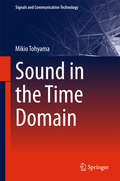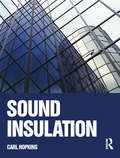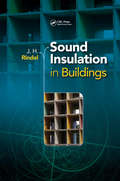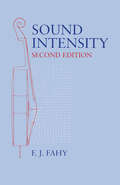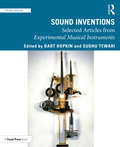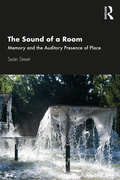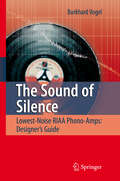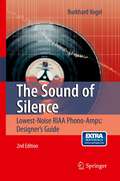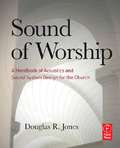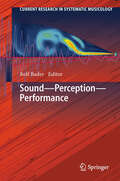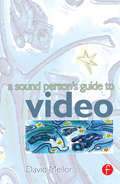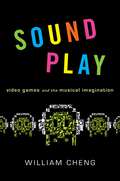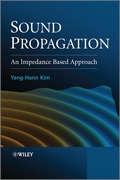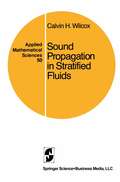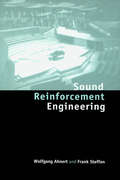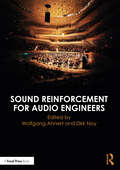- Table View
- List View
Sound in the Time Domain (Signals and Communication Technology)
by Mikio TohyamaThis book addresses the nature of sound, focusing on the characteristics of sound waves in the context of time structures. This time domain approach provides an informative and intuitively understandable description of various acoustic topics such as sound waves travelling in an acoustic tube or in other media where spectral or modal analysis can be intensively performed. Starting from the introductory topic of sinusoidal waves, it discusses the formal relationship between the time and frequency domains, summarizing the fundamental notions of Fourier or z-transformations and linear systems theory, along with interesting examples from acoustical research. The books novel approach is of interest to research engineers and scientists In particular, the expressions concerning waveforms including the impulse responses are important for audio engineers who are familiar with digital signal analysis. Every chapter includes simple exercises designed to be solved without the need for a computer. Thus they help reconfirm the fundamental ideas and notions present in every chapter. The book is self-contained and concise, and requires only basic knowledge of acoustics and signal processing, making it valuable as a textbook for graduate and undergraduate university courses.
Sound Insulation
by Carl HopkinsSound insulation is an important aspect of building performance. This book is a comprehensive guide to sound and vibration theory and its application to the measurement and prediction of sound insulation in buildings. It enables the reader to tackle a wide range of issues relating to sound insulation during the design and construction stages of a building, and to solve problems in existing buildings. The book has been written for engineers, consultants, building designers, students in acoustics, researchers and those involved in the manufacture and design of building products. Key aspects are that it:* Explains the fundamental theory using examples that show its direct application to buildings* Guides the reader through the links between measurement and theory* Explains concepts that are important for the application, interpretation and understanding of guidance documents, test reports, product data sheets, published papers, regulations and Standards* Makes direct reference to ISO and EN Standards on sound insulation* Contains a large number of illustrations showing measurements, predictions and example calculations for quick referenceCarl Hopkins previously worked on building acoustics and environmental noise at the Building Research Establishment. During this time he was involved with sound insulation in research, consultancy, standardization, and building regulations as well as being an advisor on acoustics to government departments. He is currently a Senior Lecturer at the University of Liverpool within the Acoustics Research Unit of the School of Architecture.
Sound Insulation
by Carl HopkinsSound insulation is an important aspect of building performance. This book is a comprehensive guide to sound and vibration theory and its application to the measurement and prediction of sound insulation in buildings. It enables the reader to tackle a wide range of issues relating to sound insulation during the design and construction stages of a building, and to solve problems in existing buildings. The book has been written for engineers, consultants, building designers, students in acoustics, researchers and those involved in the manufacture and design of building products. Key aspects are that it:* Explains the fundamental theory using examples that show its direct application to buildings* Guides the reader through the links between measurement and theory* Explains concepts that are important for the application, interpretation and understanding of guidance documents, test reports, product data sheets, published papers, regulations and Standards* Makes direct reference to ISO and EN Standards on sound insulation* Contains a large number of illustrations showing measurements, predictions and example calculations for quick referenceCarl Hopkins previously worked on building acoustics and environmental noise at the Building Research Establishment. During this time he was involved with sound insulation in research, consultancy, standardization, and building regulations as well as being an advisor on acoustics to government departments. He is currently a Senior Lecturer at the University of Liverpool within the Acoustics Research Unit of the School of Architecture.
Sound Insulation in Buildings
by Jens Holger RindelThe book explains sound insulation in buildings at a level suitable for both graduate students and expert consultants. Theoretical models are set out for sound transmission in buildings, with an emphasis on thick and heavy constructions. Thus, the description is not restrained by the common assumption of bending waves which is characteristic of thin plates, only. A general description is provided, with the modal density in the structures as a key parameter. At low frequencies statistical energy analysis is replaced by modal energy analysis. Sound transmission through windows and facades is represented by a model that allows any angle on incidence, including the special case of grazing incidence. One chapter is devoted to the subjective evaluation of sound insulation, particularly noise from neighbours, and how this can be applied in a sound classification scheme for dwellings. Measurement methods in building acoustics are presented with emphasis on modern methods using MLS signals or sine sweeps. The analysis and estimation of measurement uncertainty is discussed in detail. In a final chapter examples of experimental buildings with high sound insulation are explained.
Sound Insulation in Buildings
by Jens Holger RindelThe book explains sound insulation in buildings at a level suitable for both graduate students and expert consultants. Theoretical models are set out for sound transmission in buildings, with an emphasis on thick and heavy constructions. Thus, the description is not restrained by the common assumption of bending waves which is characteristic of thin plates, only. A general description is provided, with the modal density in the structures as a key parameter. At low frequencies statistical energy analysis is replaced by modal energy analysis. Sound transmission through windows and facades is represented by a model that allows any angle on incidence, including the special case of grazing incidence. One chapter is devoted to the subjective evaluation of sound insulation, particularly noise from neighbours, and how this can be applied in a sound classification scheme for dwellings. Measurement methods in building acoustics are presented with emphasis on modern methods using MLS signals or sine sweeps. The analysis and estimation of measurement uncertainty is discussed in detail. In a final chapter examples of experimental buildings with high sound insulation are explained.
Sound Intensity
by Frank FahyThe advent of instruments capable of measuring sound intensity, which represents the flow of energy in sound fields, has revolutionised audio-frequency acoustical metrology. Since publication of the first edition, two International Standards for the use of sound intensity for sound source power determination, and one International Standard for sound intensity instrumentation, have also been published. A number of International Standards have also been developed.
Sound Intensity
by Frank FahyThe advent of instruments capable of measuring sound intensity, which represents the flow of energy in sound fields, has revolutionised audio-frequency acoustical metrology. Since publication of the first edition, two International Standards for the use of sound intensity for sound source power determination, and one International Standard for sound intensity instrumentation, have also been published. A number of International Standards have also been developed.
Sound Inventions: Selected Articles from Experimental Musical Instruments (Sound Design)
by Bart Hopkin Sudhu TewariSound Inventions is a collection of 34 articles taken from Experimental Musical Instruments, the seminal journal published from 1984 through 1999. In addition to the selected articles, the editors have contributed introductory essays, placing the material in cultural and temporal context, providing an overview of the field both before and after the time of original publication. The Experimental Musical Instruments journal contributed extensively to a number of sub-fields, including sound sculpture and sound art, sound design, tuning theory, musical instrument acoustics, timbre and timbral perception, musical instrument construction and materials, pedagogy, and contemporary performance and composition. This book provides a picture of this important early period, presenting a wealth of material that is as valuable and relevant today as it was when first published, making it essential reading for anyone researching, working with or studying sound.
Sound Inventions: Selected Articles from Experimental Musical Instruments (Sound Design)
by Bart Hopkin Sudhu TewariSound Inventions is a collection of 34 articles taken from Experimental Musical Instruments, the seminal journal published from 1984 through 1999. In addition to the selected articles, the editors have contributed introductory essays, placing the material in cultural and temporal context, providing an overview of the field both before and after the time of original publication. The Experimental Musical Instruments journal contributed extensively to a number of sub-fields, including sound sculpture and sound art, sound design, tuning theory, musical instrument acoustics, timbre and timbral perception, musical instrument construction and materials, pedagogy, and contemporary performance and composition. This book provides a picture of this important early period, presenting a wealth of material that is as valuable and relevant today as it was when first published, making it essential reading for anyone researching, working with or studying sound.
The Sound of a Room: Memory and the Auditory Presence of Place
by Seán StreetWhat does a place sound like – and how does the sound of place affect our perceptions, experiences, and memories? The Sound of a Room takes a poetic and philosophical approach to exploring these questions, providing a thoughtful investigation of the sonic aesthetics of our lived environments. Moving through a series of location-based case studies, the author uses his own field recordings as the jumping-off point to consider the underlying questions of how sonic environments interact with our ideas of self, sense of creativity, and memories. Advocating an awareness born of deep listening, this book offers practical and poetic insights for researchers, practitioners, and students of sound.
The Sound of a Room: Memory and the Auditory Presence of Place
by Seán StreetWhat does a place sound like – and how does the sound of place affect our perceptions, experiences, and memories? The Sound of a Room takes a poetic and philosophical approach to exploring these questions, providing a thoughtful investigation of the sonic aesthetics of our lived environments. Moving through a series of location-based case studies, the author uses his own field recordings as the jumping-off point to consider the underlying questions of how sonic environments interact with our ideas of self, sense of creativity, and memories. Advocating an awareness born of deep listening, this book offers practical and poetic insights for researchers, practitioners, and students of sound.
The Sound of Silence: Lowest-Noise RIAA Phono-Amps: Designer's Guide
by Burkhard VogelThe content of this book will lead to affordable phono amplifier design approaches which will end up in lowest-noise solutions not far away from the edge of physical boundaries set by room temperature and given cartridges - thus, fully compatible with very expensive so called "high-end" or "state-of-the-art" offers on today’s markets - and, from a noise point of view in most cases outperforming them! This book demonstrates that theory is not far away from reality.
The Sound of Silence: Lowest-Noise RIAA Phono-Amps: Designer's Guide
by Burkhard VogelThere is a wide field of tasks left that can only be satisfyingly attacked with the help of old-fashioned analogue technology, and one of the most important are amplifiers for analogue signals. The strongly expanded content of the second edition of "the sound of silence" leads to affordable amplifier design approaches which will end up in lowest-noise solutions not far away from the edge of physical boundaries set by room temperature and given cartridges - thus, fully compatible with very expensive so called "high-end" or "state-of-the-art" offers on today markets - and, from a noise point of view in most cases outperforming them! With easy to follow mathematical treatment it is demonstrated as well that theory is not far away from reality. Measured SNs will be found within 1dB off the calculated ones and deviations from the exact amplifier transfer won't cross the ± 0.1dB tolerance lines. Additionally, the book presents measurement set-ups and results. Consequently, comparisons with measurement results of test magazine will soon become easier to perform. This new edition includes a new chapters about reference levels, Noise in Amp Input sections, Humming Problems, and much more.
Sound of Worship: A handbook of acoustics and sound system design for the church
by Doug JonesWhether you are designing a new system or need to update and get the most out of the one in place Sound of Worship will offer essential information to guide and inform you choices. Written to give the context to help you focus your choices as well as the technical information to understand options, this essential guide will help you avoid costly mistakes when working with acoustics and the sound systems of the church. When planning a system this book has you covered! Considering everything from building design and understanding the purpose and use of the sound system to the technical aspects of the acoustic equipment and sound specification and types. The website has numerous audio examples to illustrate points made and tools used in the book. It demonstrate the terms used and what different choices will sound like, with before and after recordings of acoustic treatment and how it effects the overall sound of the church.
Sound of Worship: A handbook of acoustics and sound system design for the church
by Doug JonesWhether you are designing a new system or need to update and get the most out of the one in place Sound of Worship will offer essential information to guide and inform you choices. Written to give the context to help you focus your choices as well as the technical information to understand options, this essential guide will help you avoid costly mistakes when working with acoustics and the sound systems of the church. When planning a system this book has you covered! Considering everything from building design and understanding the purpose and use of the sound system to the technical aspects of the acoustic equipment and sound specification and types. The website has numerous audio examples to illustrate points made and tools used in the book. It demonstrate the terms used and what different choices will sound like, with before and after recordings of acoustic treatment and how it effects the overall sound of the church.
Sound - Perception - Performance (Current Research in Systematic Musicology #1)
by Rolf BaderMusical Performance covers many aspects like Musical Acoustics, Music Psychology, or motor and prosodic actions. It deals with basic concepts of the origin or music and its evolution, ranges over neurocognitive foundations, and covers computational, technological, or simulation solutions. This volume gives an overview about current research in the foundation of musical performance studies on all these levels. Recent concepts of synchronized systems, evolutionary concepts, basic understanding of performance as Gestalt patterns, theories of chill as performance goals or historical aspects are covered. The neurocognitive basis of motor action in terms of music, musical syntax, as well as therapeutic aspects are discussed. State-of-the-art applications in performance realizations, like virtual room acoustics, virtual musicians, new concepts of real-time physical modeling using complex performance data as input or sensor and gesture studies with soft- and hardware solutions are presented. So although the field is still much larger, this volume presents current trends in terms of understanding, implementing, and perceiving performance.
Sound Person's Guide to Video
by David MellorAn essential guide to all aspects of video technology for sound technicians wishing to broaden their knowledge. It explains in a highly readable and engaging way, the key technologies and issues, as well as the terms, acronyms and definitions. Although intended for the sound professional, this book will also appeal to anyone involved in working with video. Everything is covered: from how television and video cameras work to digital video recording, electronic news gathering, nonlinear editing, video effects as well as telecine, widescreen technology and the home cinema. The book also takes a look at the impact of digital technology on production methods and examines the technology and rationale behind digital television, High Definition Television, and DVD. It concludes with the use of video in multimedia and the internet.Based on a series of popular articles in Audio Media magazine, this a vital introductory work for students and professionals wishing to broaden their knowledge of video.
Sound Person's Guide to Video
by David MellorAn essential guide to all aspects of video technology for sound technicians wishing to broaden their knowledge. It explains in a highly readable and engaging way, the key technologies and issues, as well as the terms, acronyms and definitions. Although intended for the sound professional, this book will also appeal to anyone involved in working with video. Everything is covered: from how television and video cameras work to digital video recording, electronic news gathering, nonlinear editing, video effects as well as telecine, widescreen technology and the home cinema. The book also takes a look at the impact of digital technology on production methods and examines the technology and rationale behind digital television, High Definition Television, and DVD. It concludes with the use of video in multimedia and the internet.Based on a series of popular articles in Audio Media magazine, this a vital introductory work for students and professionals wishing to broaden their knowledge of video.
Sound Play: Video Games and the Musical Imagination (Oxford Music / Media)
by William ChengVideo games open portals to fantastical worlds where imaginative play and enchantment prevail. These virtual settings afford us considerable freedom to act out with relative impunity. Or do they? Sound Play explores the aesthetic, ethical, and sociopolitical stakes of people's creative engagements with gaming's audio phenomena-from sonorous violence to synthesized operas, from democratic music-making to vocal sexual harassment. William Cheng shows how video games empower their designers, composers, players, critics, and scholars to tinker (often transgressively) with practices and discourses of music, noise, speech, and silence. Faced with collisions between utopian and alarmist stereotypes of video games, Sound Play synthesizes insights across musicology, sociology, anthropology, communications, literary theory, philosophy, and additional disciplines. With case studies spanning Final Fantasy VI, Silent Hill, Fallout 3, The Lord of the Rings Online, and Team Fortress 2, this book insists that what we do in there-in the safe, sound spaces of games-can ultimately teach us a great deal about who we are and what we value (musically, culturally, humanly) out here. Foreword by Richard Leppert Video Games Live cover image printed with permission from Tommy Tallarico
Sound Play: Video Games and the Musical Imagination (Oxford Music / Media)
by William ChengVideo games open portals to fantastical worlds where imaginative play and enchantment prevail. These virtual settings afford us considerable freedom to act out with relative impunity. Or do they? Sound Play explores the aesthetic, ethical, and sociopolitical stakes of people's creative engagements with gaming's audio phenomena-from sonorous violence to synthesized operas, from democratic music-making to vocal sexual harassment. William Cheng shows how video games empower their designers, composers, players, critics, and scholars to tinker (often transgressively) with practices and discourses of music, noise, speech, and silence. Faced with collisions between utopian and alarmist stereotypes of video games, Sound Play synthesizes insights across musicology, sociology, anthropology, communications, literary theory, philosophy, and additional disciplines. With case studies spanning Final Fantasy VI, Silent Hill, Fallout 3, The Lord of the Rings Online, and Team Fortress 2, this book insists that what we do in there-in the safe, sound spaces of games-can ultimately teach us a great deal about who we are and what we value (musically, culturally, humanly) out here. Foreword by Richard Leppert Video Games Live cover image printed with permission from Tommy Tallarico
Sound Propagation: An Impedance Based Approach
by Yang-Hann KimIn Sound Propagation: An Impedance Based Approach, Professor Yang-Hann Kim introduces acoustics and sound fields by using the concept of impedance. Kim starts with vibrations and waves, demonstrating how vibration can be envisaged as a kind of wave, mathematically and physically. One-dimensional waves are used to convey the fundamental concepts. Readers can then understand wave propagation in terms of characteristic and driving point impedance. The essential measures for acoustic waves, such as dB scale, octave scale, acoustic pressure, energy, and intensity, are explained. These measures are all realized by one-dimensional examples, which provide mathematically simplest but clear enough physical insights. Kim then moves on to explaining waves on a flat surface of discontinuity, demonstrating how propagation characteristics of waves change in space when there is a distributed impedance mismatch. Next is a chapter on radiation, scattering, and diffraction, where Kim shows how these topics can be explained in a unified way, by seeing the changes of waves due to spatially distributed impedance. Lastly, Kim covers sound in closed space, which is considered to be a space that is surrounded by spatially distributed impedance, and introduces two spaces: acoustically large and small space. The bulk of the book is concerned with introducing core fundamental concepts, but the appendices are included as the essentials as well to cover other important topics to extend learning. Offers a less mathematically-intensive means to understand the subject matter Provides an excellent launching point for more advanced study or for review of the basics Based on classroom tested materials developed over the course of two decades Companion site for readers, containing animations and MATLAB code downloads Videos and impedance data available from the author's website Presentation slides available for instructor use Sound Propagation is geared towards graduate students and advanced undergraduates in acoustics, audio engineering, and noise control engineering. Practicing engineers and researchers in audio engineering and noise control, or students in engineering and physics disciplines, who want to gain an understanding of sound and vibration concepts, will also find the book to be a helpful resource.
Sound Propagation in Stratified Fluids (Applied Mathematical Sciences #50)
by Calvin H. WilcoxStratified fluids whose densities, sound speeds and other parameters are functions of a single depth coordinate occur widely in nature. Indeed, the earth's gravitational field imposes a stratification on its atmosphere, oceans and lakes. It is well known that their stratification has a profound effect on the propagation of sound in these fluids. The most striking effect is probably the occurrence of acoustic ducts, due to minima of the sound speed, that can trap sound waves and cause them to propagate hori zontally. The reflection, transmission and distortion of sonar signals by acoustic ducts is important in interpreting sonar echoes. Signal scattering by layers of microscopic marine organisms is important to both sonar engi neers and marine biologists. Again, reflection of signals from bottom sediment layers overlying a penetrable bottom are of interest both as sources of unwanted echoes and in the acoustic probing of such layers. Many other examples could be given. The purpose of this monograph is to develop from first principles a theory of sound propagation in stratified fluids whose densities and sound speeds are essentially arbitrary functions of the depth. In physical terms, the propagation of both time-harmonic and transient fields is analyzed. The corresponding mathematical model leads to the study of boundary value problems for a scalar wave equation whose coefficients contain the pre scribed density and sound speed functions.
Sound Reinforcement Engineering: Fundamentals and Practice
by Wolfgang Ahnert Frank SteffenSound reinforcement is the increasing of the power of sound signals and reproducing them as acoustic signals. This book gives an introduction to the fundamentals of sound reinforcement engineering, and also explains how it relates to disciplines such as room acoustics. It discusses in detail the components and layout of sound reinforcement systems
Sound Reinforcement for Audio Engineers
by Wolfgang AhnertSound Reinforcement for Audio Engineers illustrates the current state of the art in sound reinforcement. Beginning with an outline of various fields of applications, from sports venues to religious venues, corporate environments and cinemas, this book is split into 11 chapters covering room acoustics, loudspeakers, microphones and acoustic modelling among many other topics. This comprehensive book packed with references and a historical overview of sound reinforcement design is an essential reference book for students of acoustics and electrical engineering, but also for engineers looking to expand their knowledge of designing sound reinforcement systems.
Sound Reinforcement for Audio Engineers
by Wolfgang Ahnert Dirk NoySound Reinforcement for Audio Engineers illustrates the current state of the art in sound reinforcement. Beginning with an outline of various fields of applications, from sports venues to religious venues, corporate environments and cinemas, this book is split into 11 chapters covering room acoustics, loudspeakers, microphones and acoustic modelling among many other topics. This comprehensive book packed with references and a historical overview of sound reinforcement design is an essential reference book for students of acoustics and electrical engineering, but also for engineers looking to expand their knowledge of designing sound reinforcement systems.
